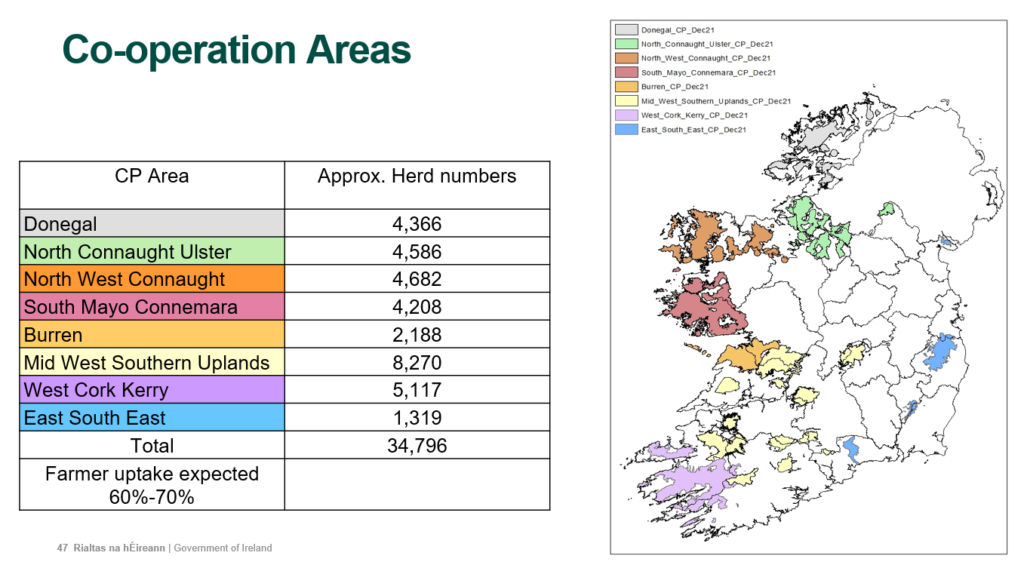Agri-Environment Climate Measure (AECM) in the next CAP
The €1.5 billion Agri-Environment Climate Measure (AECM) will replace GLAS in the next CAP, which will come into effect in January 2023.
According to the Department of Agriculture, Food, and the Marine, this will be “more environmentally ambitious, more targeted and more innovative” than the current GLAS scheme.
The AECM advocates what the DAFM views as a transition from species-specific focus to habitat establishment and enchantment of habitat quality.
It will involve moving from a prescription-based scheme to a hybrid-based scheme (prescription-based measures and results-based measures).
The scheme, which has the underpinning principle: ‘the right action, in the right place’, will contain a “broader” range of actions than GLAS. Furthermore, it will also involve the construction of a farm sustainability plan (FSP).
In its draft CSP, the DAFM explains that this is one scheme with two measures.
Farmers, therefore, can only apply for one measure and have one contract.
The two measures are:
- General measure;
- Co-operation measure.
Who is eligible, and when will it open?
- An eligible farmer in any part of the country may apply to participate in the Scheme, which will also include submitting a farm sustainability plan.
- Intake on a phased basis via tranches for both measures subject to DAFM and advisor capacity
- Tranche 1: Open Q4 2022;
- Tranche 2: Open Q4 2023;
- The DAFM confirmed there is a possibility of Tranche 3 – depending on uptake
- Tiered structure (similar to GLAS) – applicants will receive priority entry based on which tier they are eligible for
TIER 1 Priority Environmental Assets (‘PEAs’)
To qualify for Tier 1, the applicant must commit to completing appropriate mandatory actions relevant to the Priority Environmental Assets (PEA) on their holding.
- Private Natura;
- Commonage;
- Geese and Swans area;
- Breeding Wader mapped areas;
- Catchments identified as having high-status water – actions appropriate to local needs, identified in the Farm Sustainability Plan;
- Conservation of rare breeds
- Registered Organic farmers will also qualify for priority access under this Tier.
TIER 2 Priority Environmental Actions
Farmers whose lands include a vulnerable water area may apply for access to the scheme under Tier 2.
Applicants may also be considered under Tier 2:
if s/he is a participant in the Native Woodland Establishment Scheme or GPC 11 – Agroforestry or if s/he adopts at least one of the tree planting actions
In the absence of either of the above, if an applicant, (whether beef, dairy or sheep) has a whole farm stocking rate exceeding
- 130 kg livestock manure Nitrogen per hectare (ha) produced on the holding, or
- Has more than 30 hectares (ha) of arable crops;
S/he must adopt at least one of the following mandatory actions:
- Minimum tillage;
- Catch crops;
- Over winter stubble;
- Grass margins arable or grass margins grassland;
- Low input peat grassland.
TIER 3 General actions
These actions aim to address climate change, water quality and biodiversity benefits and may be chosen in addition to any mandatory Tier 1 or Tier 2 actions.

Source: DAFM

Co-operation measure – structure and actions
Results-based payments: This is the core payment for all coop group participants. It will relate to the habitat quality scores for the farmer’s land. Typically, scorecards are used for the following habitats:
- Grasslands;
- Woodlands;
- Peatlands.
Non-productive investments (NPI): Where a farmer seeks to improve the habitat quality score of their land through further actions, they can avail of NPIs measures e.g.
- Control of invasive species;
- Improvements to grazing infrastructure;
- Water provision for livestock.
Cooperation actions: Generally relate to actions that may be carried out on a landscape scale.
- Co-operative teams will develop these depending on local needs and objectives e.g.
- Fire prevention;
- Predator control;
- Flood prevention measures.
Role of the co-operation teams
- Liaise with NPWS and LAWPRO at a local level to ensure local priorities and needs are identified;
- Work with farmers and communities to develop appropriate landscape projects and foster community involvement;
- Develop a local action plan to deliver “optimum” environment benefits;
- Provide ongoing support to advisors and farmers.
Scorecards
As this is a resulted-based scheme, the DAFM links payments to biodiversity/habitat quality and assesses this using scorecards with a 1-10-point scale.
Farmers may be familiar with this payment method if they are a REAP scheme participants
According to the DAFM, the higher the quality, the higher a farmers’ payment level will be. For example, if you obtain a score of 10, you will avail of the optimum payment rate.
The DAFM, in its plan, states that the scorecard will address issues such as the ecological and hydrological integrity of the land.
Payment measures: Agri-Environment Climate Measure
According to the DAFM, in the general measure, it has a target of 30,000 farmers, which would result in a maximum annual payment of €7,300/farmer.
The DAFM estimates the average payment per farmer per year to be in the region of €5,000, which leads this measure to cost €150m per annum.
On the other hand, in the cooperation measure, it has a target of 20,000 farmers, which would result in a maximum annual payment of €10,500/farmer.
Furthermore, the DAFM estimates the average payment per farmer per year to be €7,000/farmer, with an annual funding provision of €150m.
When will the scheme open?
- In June 2022, DAFM hopes to open the access agreement to allow advisors to gain access to client data;
- In summer 2022, the DAFM hopes to open the farm sustainability plan;
- Furthermore, depending on the CSP’s approval, it expects to open the application window in October-November 2022;
- Approve and commence contracts – January 2023.
Other articles on That’s Farming:





